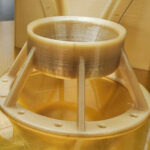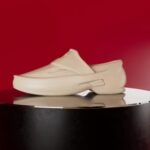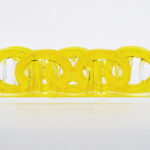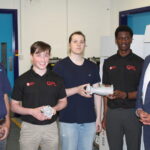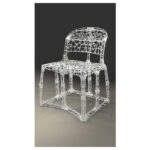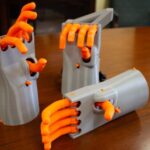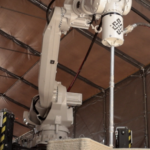Comparing cost of filament
Comparing cost of filament can get down right confusing. Most filament is sold by weight, but different manufacturers offer different their products in a variety of weights, some in Kilograms and others in pounds or fractions thereof. In addition, some materials are denser (heavier) than others. How then, to compare the cost of using one filament vs another?
There are five major factors in getting to the real cost of printing with one filament vs another:
- price
- density of filament
- print density (infill strategy, shell layers, etc.)
- waste per print (setup, purging, cleaning)
- risk of botched print (variable extrusion behavior of filament, printing settings, integrity of .STL file, etc.)
The first three factors are specific and can be used to calculate base costs. (Factors 4 & 5 are subject to the printer hardware, file and other factors, so we will save comments on them for another article.)
Volume Matters… Not Weight!
What really matters in calculating the costs of printing is the cost per volume of print; ie cubic inch or cubic centimeter.
Doing the math for comparing say 1 Kg reel of ABS vs a 1 lb reel of Polycarbonate can be a hair pulling experience; so we have done the math for you. You will find below a simple equation for calculating the actual cost of a solid printed cube (1 inch by 1 inch by 1 inch) to determine a filament’s cost per cubic inch.
How To Calculate The Cost of a Solid Cubic Inch of Filament
Here is what you need to calculate:
- filament type
- weight per reel
- price
- filament density (specific gravity)
You can fill in your selected filament type, price and weight, and quickly get accurate cost and volume numbers that allow you to do real comparisons.
Example 1:
| Filament type: | ABS |
| Weight per reel: | 1.0 Kg |
| Price: | $50.00 |
| Specific Gravity: | 1.045* |
*Specific gravity is the ratio of a material’s density to the density of water. One cubic centimeter of water weights one gram.
Here’s how to use this data. Fill in the bolded parts of the following equation:
cost per cubic inch =
16.39 cubic centimeters/ cubic inch x (SPECIFIC GRAVITY ) x (PRICE per Kg) divided by 1,000 cubic cm per Kg.
Or, for prices quoted in lbs:
16.39 cubic centimeters/ cubic inch x (SPECIFIC GRAVITY ) x (PRICE per Lb) divided by
454.5 cubic cm per Lb.
In this case, insert $50.00 and 1.045 in this equation and you get:
16.39 cubic centimeters/ cubic inch x (1.045) x ($50.00 per Kg) divided by 1,000 cubic cm per Kg = $0.86 per cubic inch
Example 2:
| Filament type: | Polycarbonate |
| Weight per reel: | 1 lb. |
| Price: | $45.00 |
| Specific Gravity: | 1.21 |
16.39 cubic centimeters/ cubic inch x (1.21) x ($45 per Lb) divided by 454.5 cubic cm per Lb. =
$1.96 per cubic inch.
If you were going to print 100% solid objects, the polycarbonate would be more than twice the cost per cubic inch. Factoring for the percentage infill will reduce the cost per cubic inch for both filaments. Because Polycarbonate exhibits higher mechanical strength, you may decide to use a lower infill and fewer outer layer shells, which would reduce the actual printed cost per cubic inch. This is often appropriate, when using higher performance, engineering grade filaments, such as polycarbonate, ULTEM and PEEK. I will cover this in more detail in a future article.
Enclosed below is a chart of specific gravity for most commonly used filaments and some high performance, engineering grade filaments for comparison.
Specific Gravity Chart:
You can see that a filament’s density can have a major effect on its cost relative to another filament on a volume basis.
So before you compare filaments on price, make sure to check their specific gravity values so you can compare them on a cost per volume basis; which is what really matters when printing 3D objects.
| CONVENTIONAL FILAMENTS | SPECIFIC GRAVITY | HIGH PERFORMANCE FILAMENTS | SPECIFIC GRAVITY |
|---|---|---|---|
| PLA | 1.24 | CARBON FIBER ABS | 1.18-.140* |
| ABS | 1.04 | CARBON FIBER NYLON | 1.30-1.50* |
| TPU | 1.23 – 1.55 | ULTEM 9085 | 1.34 |
| POLYCARBONATE | 1.21 | PEEK | 1.31 |
* range estimate based on % CF
Helpful Conversions:
There are 1,000 grams in one Kilogram. There are 1,000 cubic centimeters of water in a Kilogram of water.
There number of cubic centimeters in a Kilogram of filament equals the 1,000 cubic centimeters
multiplied by the specific gravity of the specified filament.
There are 2.2 lbs in 1 Kg.
There are 16.39 cubic cm in a cubic inch.


